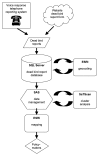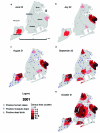Dead bird clusters as an early warning system for West Nile virus activity
- PMID: 12781002
- PMCID: PMC3000152
- DOI: 10.3201/eid0906.020794
Dead bird clusters as an early warning system for West Nile virus activity
Abstract
An early warning system for West Nile virus (WNV) outbreaks could provide a basis for targeted public education and surveillance activities as well as more timely larval and adult mosquito control. We adapted the spatial scan statistic for prospective detection of infectious disease outbreaks, applied the results to data on dead birds reported from New York City in 2000, and reviewed its utility in providing an early warning of WNV activity in 2001. Prospective geographic cluster analysis of dead bird reports may provide early warning of increasing viral activity in birds and mosquitoes, allowing jurisdictions to triage limited mosquito-collection and laboratory resources and more effectively prevent human disease caused by the virus. This adaptation of the scan statistic could also be useful in other infectious disease surveillance systems, including those for bioterrorism.
Figures



Similar articles
-
Dead bird surveillance as an early warning system for West Nile virus.Emerg Infect Dis. 2001 Jul-Aug;7(4):631-5. doi: 10.3201/eid0704.010405. Emerg Infect Dis. 2001. PMID: 11585524 Free PMC article.
-
West Nile virus infection in birds and mosquitoes, New York State, 2000.Emerg Infect Dis. 2001 Jul-Aug;7(4):679-85. doi: 10.3201/eid0704.010415. Emerg Infect Dis. 2001. PMID: 11585532 Free PMC article.
-
West Nile virus in New York State: the 1999 outbreak and response plan for 2000.Viral Immunol. 2000;13(4):463-7. doi: 10.1089/vim.2000.13.463. Viral Immunol. 2000. PMID: 11192292 No abstract available.
-
Control of arbovirus infections by a coordinated response: West Nile Virus in England and Wales.FEMS Immunol Med Microbiol. 2006 Dec;48(3):305-12. doi: 10.1111/j.1574-695X.2006.00159.x. Epub 2006 Oct 20. FEMS Immunol Med Microbiol. 2006. PMID: 17054715 Review.
-
West Nile virus: an emerging virus in North America.Clin Lab Sci. 2003 Winter;16(1):43-9. Clin Lab Sci. 2003. PMID: 12587658 Review.
Cited by
-
Spatio-temporal analysis of malaria within a transmission season in Bandiagara, Mali.Malar J. 2013 Mar 1;12:82. doi: 10.1186/1475-2875-12-82. Malar J. 2013. PMID: 23452561 Free PMC article.
-
Space-time clustering of childhood malaria at the household level: a dynamic cohort in a Mali village.BMC Public Health. 2006 Nov 21;6:286. doi: 10.1186/1471-2458-6-286. BMC Public Health. 2006. PMID: 17118176 Free PMC article.
-
Public health preparedness of health providers: meeting the needs of diverse, rural communities.J Natl Med Assoc. 2006 Nov;98(11):1784-91. J Natl Med Assoc. 2006. PMID: 17128688 Free PMC article.
-
Spatial patterns of fetal loss and infant death in an arsenic-affected area in Bangladesh.Int J Health Geogr. 2010 Oct 26;9:53. doi: 10.1186/1476-072X-9-53. Int J Health Geogr. 2010. PMID: 20977746 Free PMC article.
-
Spatial clustering of HIV prevalence in Atlanta, Georgia and population characteristics associated with case concentrations.J Urban Health. 2011 Feb;88(1):129-41. doi: 10.1007/s11524-010-9510-0. J Urban Health. 2011. PMID: 21249526 Free PMC article.
References
-
- Centers for Disease Control and Prevention. West Nile virus activity—United States, November 7–13, 2002. MMWR Morb Mortal Wkly Rep. 2002;51:1026–7.
Publication types
MeSH terms
LinkOut - more resources
Full Text Sources
Medical
